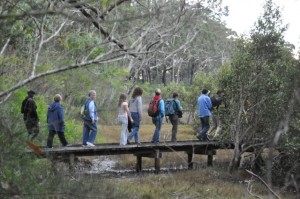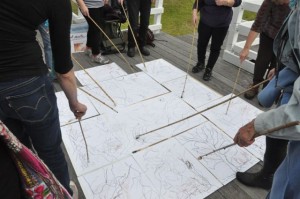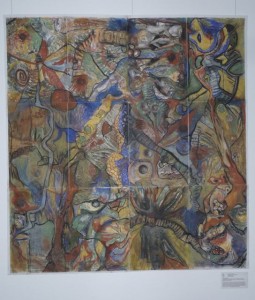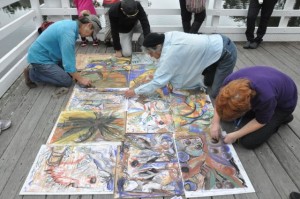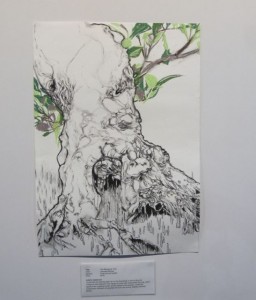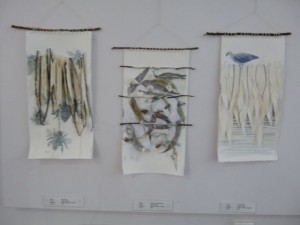The environment has always provided inspiration for the arts.
Always has, always will.
Reading the Land is a project bringing artists and environmentalists together. It took place in Huskisson on World Environment Day, in June 2013.
Reading the Land is supported by Shoalhaven Landcare. It’s planned for other areas of the Shoalhaven in 2014. Let me know if you would like to know more.
And you can read about the Huskisson (2013) event – and some possibilities for its future – below:
READING THE LAND
A gardener, a Koori and an ecologist went for a walk. They ambled along a boardwalk, marvelling at the mangrove forest on a coastal creek, replete with scurrying crabs and unexplained squelching sounds. Heading inland they noted native honeybees, high in a bloodwood, and pondered the future of this forest in the face of the expected rising sea levels. Next they examined a native plant garden, showcasing the range of local species, many little known and misunderstood. As they walked they spoke, from their individual perspectives, of their feelings about this land, its past, its present and its future. About how they read the land. Along with them, on this ambling walk and joining in the conversation, was a group of 30 artists.
The environment has always provided inspiration for the arts, in all its forms. Always has, always will. Traditional Australian Indigenous art demonstrates this through rock painting and carving, bark painting, wood carving, weaving, dance and song, all intrinsically linked with land and dreaming stories. Contemporary Indigenous art carries these stories with modern materials.
Landscape paintings have been a constant since the earliest days of European occupation. These were inspired by the uniqueness of the Australian environment. Trees that drop bark, not leaves. Pouched animals, egg-laying mammals. Fire, fire everywhere fire.
The work of wilderness photographer Peter Dombrovskis has been credited with changing public attitudes to damming Tasmania’s Franklin River. Similar work has featured in numerous environmental campaigns. And adorns the walls of many a multinational boardroom.
British sculptor Antony Gormley’s installation of 51 steel figures at Lake Ballard, a usually dry salt lake 180 kilometres north of Kalgoorlie, takes advantage of the stunning landscape, inviting contemplation and appreciation. A similar work is proposed for the Snowy Mountains. Other installations, whether temporary or permanent, tell stories of place, of people and their interactions.
Tim Winton’s various portrayals of the Western Australia landscape enrich his work and bring his stories alive to the point where readers can feel the sand, taste the salt. Richard Flanagan does the same with his novels set in Tasmania. Literature set in place can be found in the anthologies of western Sydney writers published by the Westside Writers Group. Much earlier, in We of the Never Never, Jeannie (Mrs Aeneas) Gunn’s autobiographical novel of her time at the beginning of the 20th century in the Northern Territory met a market for stories of this wild and remote land. Earlier still, in 1891’s “In the Droving Days,” Banjo Patterson provided a lesson that not all that is valuable is bright and glossy:
For those that love it and understand
The saltbush plain is a wonderland
Poet Judith Wright’s work had an overt focus on the environment and the relationship of people to it. In her spare time Wright devoted herself to environmental and social activism, with a particular interest in Aboriginal reconciliation. All things are connected. John Kinsella’s poetry and novels are inspired by the Australian landscape. The publisher’s blurb from Kinsella’s The New Arcadia makes his worldview clear:
Analogies are made between the pastoral idyll and the radical an
antipastoral necessitated by today’s rural world (salinity, pesticides,
road kill, soil erosion, and dispossession of indigenous peoples).
In 1993 the Australian music group Sirocco performed original music from the Wetlands Suite at a concert in the Macquarie Marshes in central northern NSW, drawing attention to the perilous plight of these internationally significant wetlands. From humanity’s earliest injustices protest songs have been a popular means of resistance, of raising awareness. Midnight Oil provide many fine examples.
Dance and theatre tell stories of place, people and sometimes issues. Such as environmental threats. Coal seam gas and other economic achievements have given life to numerous performances. Street theatre is the theatre of protest. Just as the environment inspires the arts, in all its forms, the arts sustain activism.
Art has the capacity to lift the spirits, to engage and to change peoples thinking. The first images of earth taken from outer space bought home the cold hard fact that we all live in a world with finite resources.
The walk led by the gardener, the Koori and the ecologist included a boardwalk adjacent to Currambene Creek, that flows into Jervis Bay, south of Sydney. Here, while discussing the history of the area and the adaptations employed by mangroves to cope with tidal inundations, a little bit of magic took place. Local poet Roger Hart read from his poem Currambene Country. Previous stewardship of the land is evoked in the stanza:
A powerful place
Imbued with the spirit of those
Living here in bygone days
Evidence midden shells expose
Following the walk our group of 30 artists were invited to interpret what they had seen and heard in their art. This Reading of the Land took place during a World Environment Day festival in Huskisson, on Jervis Bay’s shores, in early June 2013. Some of the artists produced art then and there, some later. Some did both. People like to see artists at work and the very public production of art was a popular attraction to festival goers.
This culminated in an art exhibition opening three months later at Huskisson’s Lady Denman Museum and Gallery. Individual work from 15 artists and one large collaborative effort produced by art students from what’s left of the local TAFE College arts program went on display for four weeks.
Imagining Currambene, Diploma of Art students, Nowra TAFE
Artists were asked to provide a statement showing how they had attempted to interpret what they had seen and heard during the walk. With a light note, here’s one view:
Your world – Our world
Without you we can exist
Without us you can’t exist for long
And how dull in the meantime that would be
Kerrie Sawtell, Artist’s statement
Oil and acrylic are common offerings, weaving from natural fibres makes an appearance, as does textile art, a small installation and smart phone photography. A kind of reverse ekphrasis arises with photo art produced to support the themes explored in Roger Hart’s poem Currambene Country. Wonder at nature’s bounty and respect for Indigenous people is evident in one artist’s statement:
“I live close to Currambene Creek. Its tidal waters and luxuriant
mangrove forests are a rich environment. The first Australians had a
marvellous choice for food. Low tide would be the time to check the
traps for fish or crabs and to collect oysters, shellfish and search the
mangrove trees for bird nests and eggs.”
Margot Curtis, Artist’s statement
The fine detail of the pneumatophore, the aerial root the mangrove employs to cope with tidal inundation, is captured plein-air in charcoal and pastel. A landscape you feel you are walking into, drawn from charcoal, ink and gesso, woos the opening crowd. Texta joins watercolour in one work contributed by a young high school student.
Reading the Land takes it inspiration, in part, from university art programs such as the Australian National University’s “Engaging Visions,” and “Imaging the Land” at the University of NSW Arid Zone Research Station in western New South Wales, from where the shape of this essay was sketched.
Reading the land is about land literacy, the ability to read the signs of health or ill-health in a landscape. Arguably, this is a pre-requisite for sustainability. This project, in Huskisson, was an initiative of Shoalhaven Landcare.
Reading the Land is an accessible form of community art and, for many, an easy way in to artistic endeavours. There’s nothing easier than a smart phone. Making art is personally enriching. It sings to the soul. Making art in the company of others sings with greater harmony. Creative communities are innovative communities and more likely to prosper. This deserves support. Community art is widely popular, research from the Australian Council for the Arts tells us, particularly in rural areas.
The same research also points out that Australians are more likely to enjoy someone else’s art than create it themselves. For many people, their three-year-old selves who can sing, dance, draw and tell stories with ease and confidence are gradually overtaken by the pre-occupations of the materialistic and individualistic world we inhabit. Reading the Land presents opportunities for increasing participation, to reinvigorate the creative self. As my friend Bill Pigott from Berry Landcare says: “Everyone’s an artist, it’s just that some haven’t realised it yet”.
Old Mangrove Tree, Vanessa Barbay
Denman Triptych, Libby Ryder

